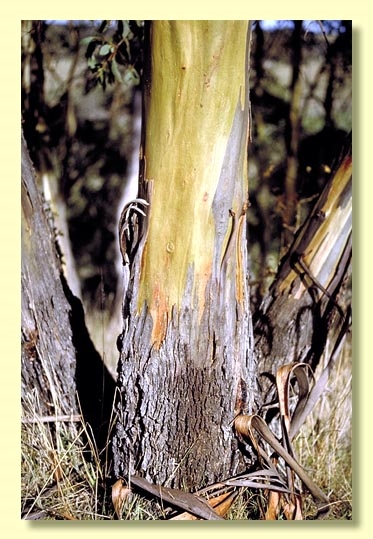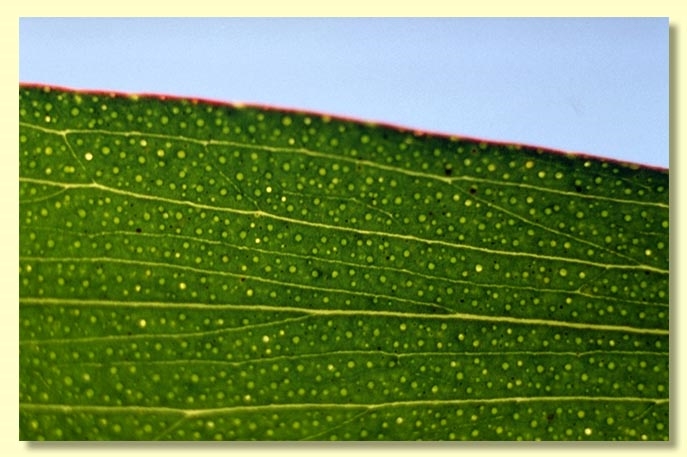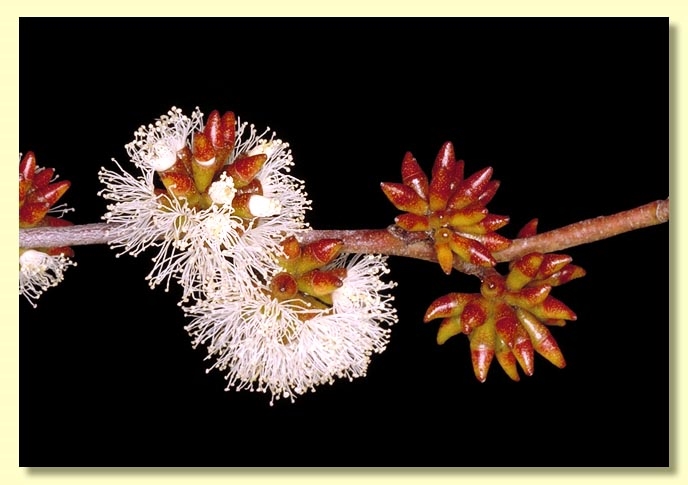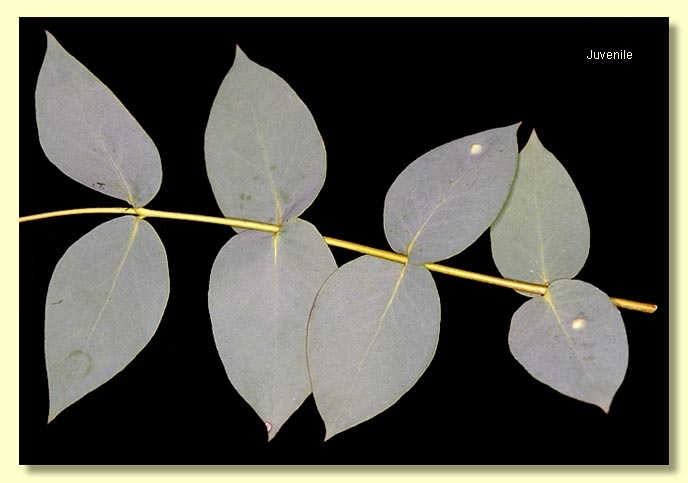Euclid - Online edition
Eucalyptus stellulata
Eucalyptus | Eucalyptus | Longitudinales
Eucalyptus stellulata Sieber ex DC., Prodr. 3: 217 (1828).
T: Port Jackson to the Blue Mts, NSW, 1823, F.W.Sieber 478; holo: G; iso: BM, FI, K, L, MEL, NSW, W.
Eucalyptus forresterae Molyneux & Rule, Muelleria 29(2) 201 (2011). T: Victoria: 6.2 km alomg Brumby Point Track from Diggers Hole Spur Road, 3703'30"S 14804'33"E, W.Molyneux & S.Forrester s.n., 15 November 2008; holo: MEL; iso: AD, CANB, HO, NSW.
Bark rough on lower trunk, compact and dark grey to black; smooth bark greenish, at times with ribbons of decorticated bark in the upper branches.
Juvenile growth (coppice or field seedlings to 50 cm): stem rounded in cross-section, often warty on lower stem, smooth on upper internodes; juvenile leaves opposite and sessile for many pairs, becoming shortly petiolate and alternate at ca 0.5–1 m tall, orbicular to elliptical becoming broadly ovate, 3.8–10 cm long, (1.7)3–5 cm wide, dull, blue-green to green.
Adult leaves alternate, petiole 0.4–1.3 cm long; blade lanceolate to elliptical, 4.7–11 cm long, 0.9–3.2 cm wide, base tapering to petiole, concolorous, glossy, green, parallel-veined, reticulation sparse or absent, intramarginal vein parallel to and well removed from margin, oil glands island.
Inflorescence axillary unbranched, peduncles 0.1–0.6 cm long, buds 9 to 15 per umbel, arranged in stellate clusters, usually sessile, rarely with 0.1 cm pedicel. Mature buds fusiform, 0.4–0.6 cm long, 0.2 cm wide, green to yellow, scar absent, operculum acutely conical, stamens irregularly flexed, anthers reniform to cordate, versatile, dorsifixed, dehiscing by confluent slits, style long, stigma tapered, locules 3, the placentae each with 2 vertical ovule rows. Flowers white.
Fruit sessile or pedicel at most 0.1 cm long, cup-shaped or truncate-globose, 0.3–0.5 cm long, 0.3–0.5 cm wide, disc level or descending, valves 3, near rim level or enclosed.
Seeds brown or reddish brown, 1.5–2 mm long, pyramidal or obliquely pyramidal, dorsal surface smooth, hilum terminal.
Cultivated seedlings (measured at ca node 10): cotyledons reniform; stems rounded in cross-section; leaves sessile and opposite throughout, cordate to almost orbicular, sometimes elliptic, 2.5–7 cm long, 2–5 cm wide, base stem-clasping to rounded or tapering, margin entire, apex rounded to pointed, dull, more or less concolorous, light green.
Flowering has been recorded in February, March, April and May.
A small tree or mallee scattered in eastern Victoria, commonly in poorly drained sites of subalpine woodlands, although occasionally on drier sites such as Brumby Point, and at lower altitudes in cold valleys, e.g. Rose and Buckland River valleys; also throughout similar subalpine and high country in New South Wales to north-east of Tenterfield, especially on basaltic soils, e.g. the Guyra–Ben Lomond plateau and near Ebor. Bark is rough on lower trunks but smooth and greenish above, adult leaves are green, glossy and with three parallel veins.
Eucalyptus stellulata belongs in Eucalyptus subgenus Eucalyptus section Longitudinales, because of the following combination of characters: mallee habit, juvenile leaves opposite for many pairs, adult leaves with side-veins more or less parallel to midrib, single axillary inflorescences, buds sessile and fusiform in stellate clusters, with buds having only one operculum, reniform anthers and ovules in two rows, and more or less pyramidal seeds. There are only three species in section Longitudinales, E. stellulata, E. mitchelliana and E. moorei (with two subspecies). E. mitchelliana is a tree or mallee restricted to the Mt Buffalo plateau in north-eatern Victoria and has whitish smooth bark. E. moorei is a mallee found scattered throughout escarpment country in eastern New South Wales and has generally shorter stature, more slender stems and smaller leaves than E. stellulata.














